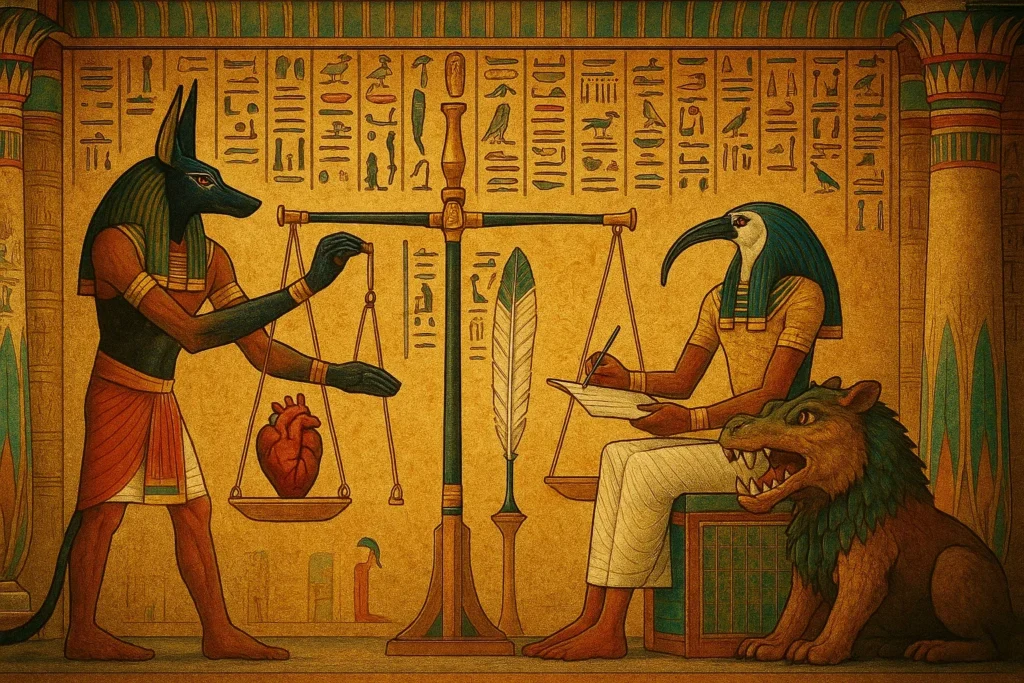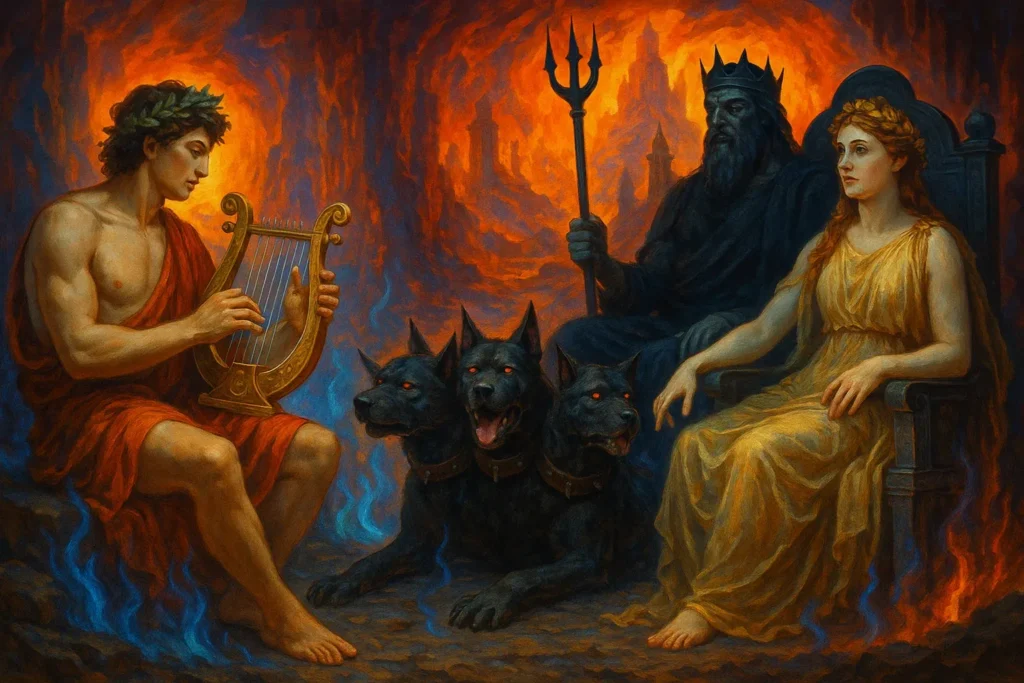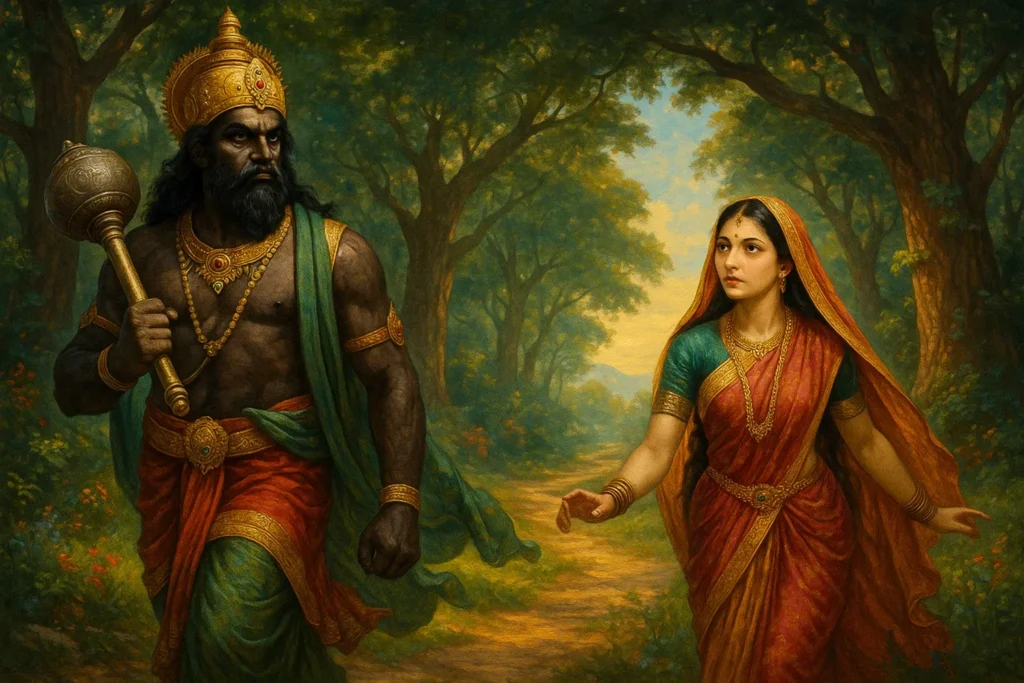When we speak of underworld adventures in mythology, we’re really asking a human question: what becomes of us after the last breath? Civilizations answered with story—grand, solemn, and strangely comforting. In India, a soul stands before Yama. In Egypt, a heart is weighed against a feather. In Greece, heroes walk into Hades and try to walk back out.
What This Article Covers
- The Hindu soul’s journey to Yama’s court
- The Egyptian Weighing of the Heart in Duat
- The Greek road to Hades—Elysium, Asphodel, Tartarus
- Cross-cultural echoes that bind these myths together
- Symbolic lessons and modern takeaways
- A concise FAQ for quick answers
Why Underworld Myths Endure
We instinctively turn the unknown into a path, a judge, a river, a gate. In doing so, cultures made death less shapeless—and life more meaningful. The best underworld adventures in mythology are really moral mirrors: they reflect our choices and promise that actions matter, even beyond the horizon.
Hindu Afterlife: Yama’s Court and the Soul’s Verdict
The Road to Judgment
In Hindu thought, death is a doorway within a larger cycle. The ātman (soul) continues its afterlife journey, guided by Yamadutas—messengers who escort it to Yamaloka. There, Yama sits as Dharma-raja, King of Justice, and listens to a life retold.
The Ledger of Karma
Chitragupta, the meticulous scribe, opens a record of deeds. Nothing is lost. Every kindness and cruelty, every vow and violation—counted. This is one of the clearest depictions in underworld adventures in mythology of a moral audit that outlives the body.
- The righteous may experience Svarga (a heavenly respite).
- Those burdened with harm endure Naraka (hells tailored to lessons needed).
- Neither is forever; the soul progresses through samsara (rebirth) until it seeks moksha (liberation).
Many Hells, One Purpose
Texts describe numerous Narakas, each aligning consequence with cause: lying, violence, betrayal, disrespect, and more. The aim is not vengeance but purification—an educative justice that prepares the soul for another chance. This restorative lens makes Hindu underworld adventures in mythology uniquely cyclical and hopeful.
Threshold Guardians
Two four-eyed hounds—Sharvara and Shyama—guard Yama’s gate. Dogs at death’s edge appear in cultures worldwide, a striking motif within underworld adventures in mythology signaling that crossing over is serious, sacred, and one-way for most.
Mortal Visitors Who Returned
A few legends bend the rule. Nachiketa bargains for wisdom in the Katha Upanishad. Savitri follows Yama to win back Satyavan with devotion, courage, and clarity. Each story says: truth, love, and knowledge can open doors even in the house of death.
Egyptian Afterlife: The Weighing of the Heart in Duat

Through Duat’s Gates
Ancient Egyptians imagined a perilous route through Duat, the realm of the dead. Spells, passwords, and virtue aided passage. The destination was the Hall of Ma’at—Truth’s tribunal—where everything came down to a single measurement.
Heart vs. Feather
Anubis sets the heart on one side of the scales, the Feather of Ma’at on the other. A light heart—honest, just, and balanced—earns entry to Aaru, the Field of Reeds: a luminous, perfected Egypt. A heavy heart meets Ammit the Devourer and a second death—no more journey, no more dawn.
This stark finality distinguishes Egyptian underworld adventures in mythology from India’s cyclical view. There are no retakes, which is why ethics, burial rites, and remembrance were so meticulously observed.
Scribes and Fair Record-Keeping
Thoth, god of writing and wisdom, records the result. The scene mirrors Yama and Chitragupta: everywhere in underworld adventures in mythology, some impartial intelligence keeps the score. The message is universal—truth matters, and nothing escapes it.
Greek Underworld: Hades, Heroes, and Moral Geography

Regions of the Dead
Greeks envisioned a varied landscape:
- Elysium: bliss for the heroic and exceptionally virtuous.
- Asphodel Fields: the neutral, ordinary afterlife for most souls.
- Tartarus: punishment for the worst crimes and hubris.
This triad echoes other underworld adventures in mythology with heaven-like, hell-like, and in-between fates.
The Crossing
Charon ferries souls across dark waters—Styx or Acheron—for a fare. Without it, some wander. Rivers, bridges, ferrymen: the liminal passage recurs across underworld adventures in mythology, emphasizing that dying is also traveling.
Cerberus at the Gate
Three heads, one job—let the dead in, let none leave. Guard animals at the threshold (Cerberus, Sharvara) reveal a shared archetype: the gate must be guarded because the boundary between life and death is not casual.
Katabasis: The Descent of the Living
Greek myth is rich with living descents:
- Orpheus charms Hades with music but loses Eurydice by looking back too soon.
- Heracles drags Cerberus to daylight as a labor and returns him.
- Odysseus speaks with shades to seek wisdom.
- Aeneas visits the dead to learn Rome’s destiny (later Roman tradition).
These stories deepen underworld adventures in mythology by framing death as a classroom—dangerous, humbling, informative.
Cross-Cultural Echoes: Why These Myths Feel Related

Judges Beyond the Veil
Yama, Osiris (with Anubis and Thoth), and Greek judges (Minos, Rhadamanthus, Aeacus) all embody post-mortem justice. Across underworld adventures in mythology, the soul meets a measure beyond human bias.
Scales, Ledgers, and Life Reviews
Whether weighed, read, or judged, the life is accounted for. A consistent signal from underworld adventures in mythology: choices matter more than circumstances, and consequence is inevitable.
Moral Geography
Heavenly meadows, neutral plains, purgative hells—maps of meaning, not just places. The cartography of the afterlife in underworld adventures in mythology teaches that reality itself is graded by ethics.
Guides and Gatekeepers
Ferrymen, hounds, angels, and psychopomps: no soul walks alone. The presence of guides in underworld adventures in mythology suggests mercy—a hand extended at the hardest moment.
Rebirth vs. Finality
India offers cycles and learning; Egypt and much of Greece present decisive verdicts. Two answers to the same anxiety appear across underworld adventures in mythology: do we evolve over lifetimes, or is this the one great test?
Symbolism and Modern Meaning

Facing Mortality
Giving death a form (Yama, Hades, Osiris) is a psychological tool. We move from fear to understanding—why underworld adventures in mythology console as much as they warn.
Accountability as Comfort
The promise that goodness is seen and injustice is not forgotten can be bracing—and healing. This is the ethical heartbeat of underworld adventures in mythology.
The Descent Within
Jung and Campbell would say: every katabasis is a metaphor. Night journeys mirror inner work—meeting shadow, seeking wisdom, returning changed. In that sense, underworld adventures in mythology are blueprints for therapy, repentance, and renewal.
Hope that Outlives Us
Rebirth, paradise, reunion, remembrance—these motifs whisper that love and virtue travel well. In practical terms, underworld adventures in mythology motivate present-tense courage, kindness, and meaning.
Quick Reference: Who’s Who and What’s Where
Hindu Highlights
- Judge: Yama (with Chitragupta)
- Fates: Svarga, Naraka, rebirth
- Themes: Restorative justice, soul’s evolution, eventual liberation
Signature motif: Two hounds at the gate; karmic ledger
Egyptian Essentials
- Judge: Osiris (Anubis weighs; Thoth records)
- Fates: Aaru (paradise) or annihilation
- Themes: Truth (Ma’at), finality, ritual preparation
Signature motif: Heart vs. feather
Greek Ground Map
- Judge(s): Minos, Rhadamanthus, Aeacus
- Fates: Elysium, Asphodel, Tartarus
- Themes: Hubris punished, virtue honored, the peril of return
Signature motif: River crossing and Cerberus
How to Read These Myths Today
For Personal Growth
- Practice a “light heart”: truth, compassion, accountability.
- Treat regret as a signal for repair, not a prison.
- Make brave descents—reflection, apology, making amends—and return wiser.
For Culture and Community
- See common ground: our ancestors shared symbols, not just borders.
- Let justice be both legal and spiritual: we need courts and consciences.
- Remember the dead well; it teaches the living how to live.
Each step honors the wisdom embedded in underworld adventures in mythology.
Conclusion: The Map Beyond the Map
Across three great civilizations—and many more—the soul’s path after death is drawn with care. Judges, bridges, scales, ledgers, meadows, abysses. The cartography differs, but the compass points align: live truthfully, love deeply, act bravely.Underworld adventures in mythology are, finally, about this world. They insist that our days are meaningful; that what we do becomes who we are; and that, when the journey continues, the best luggage is a clear conscience and a courageous heart.
FAQ
Q1: What makes Hindu underworld beliefs unique?
Hindu underworld adventures in mythology view the afterlife as part of a cycle. Souls experience results (pleasant or purifying), then return via rebirth. Justice is restorative, pointing toward liberation.
Q2: Why is the Egyptian Weighing of the Heart so iconic?
Because it compresses a lifetime into a single image: heart against feather. In Egyptian underworld adventures in mythology, truth is not an opinion but a measurement.
Q3: Did the Greeks believe everyone went to the same place?
No. Greek underworld adventures in mythology include three broad outcomes—Elysium, Asphodel, Tartarus—apportioned by judges based on a life’s quality and reverence for the gods.
Q4: Why do so many myths include guards, gates, and rivers?
They dramatize the threshold between life and death. In underworld adventures in mythology, boundaries remind us that passage is solemn, supervised, and (usually) one-way.
Q5: What practical lessons can modern readers take?
Keep your heart light (truth, empathy, repair). Accept that choices echo. And treat your own “descents” (grief, failure, fear) as journeys you can return from—changed for the better.
Notes on Sources
This synthesis draws on classical narratives from Hindu scriptures and epics, Egyptian funerary texts and iconography, and Greek and Roman mythic literature. Comparative insights follow widely recognized scholarship on myth, morality, and the hero’s descent motif.
